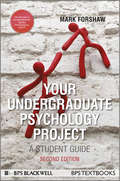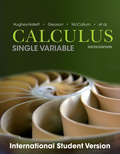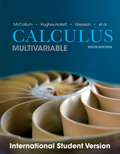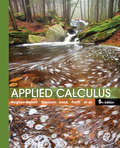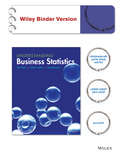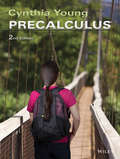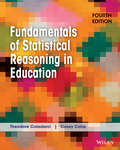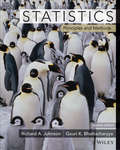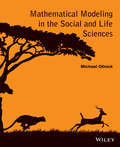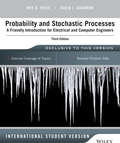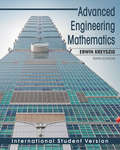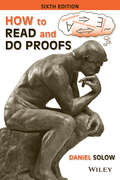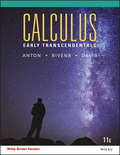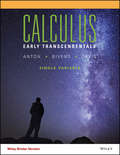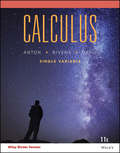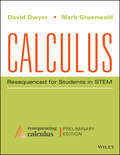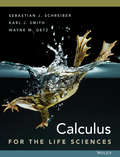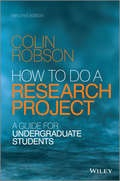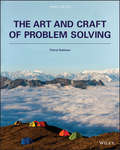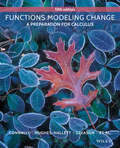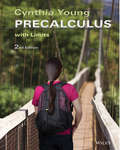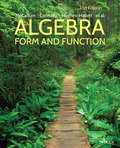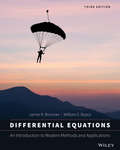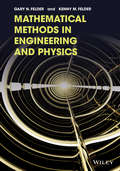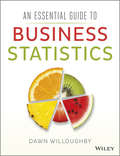- Table View
- List View
Your Undergraduate Psychology Project: A Student Guide
by Mark ForshawYour Undergraduate Psychology Project: A Student Guide has been designed with the needs of the student in mind. Packed with hints and tips, and written in a simple, informal style, this ‘second supervisor’ is designed to ease students further into the world of research. The second edition has been completely revised and updated with new material on focus groups and ethics and a new section entitled How to Lose Marks Instantly Structured chronologically around planning a project, carrying it out, and then writing it up. Gives practical advice on how to deal with day-to-day problems such as software failures or uncommunicative interviewees. Written in consultation with a number of experienced academics and students of psychology.
Calculus: Single Variable
by Deborah Hughes-Hallett Andrew M. Gleason William G. McCallum Daniel E. Flath Patti Frazer Lock David O. Lomen David Lovelock Brad G. Osgood Douglas Quinney Karen R Rhea Jeff Tecosky-Feldman Thomas W. Tucker Otto K. Bretscher Sheldon P. Gordon Andrew Pasquale Joseph ThrashThis Sixth Edition of Calculus continues the effort to promote courses in which understanding and computation reinforce each other. Calculus: Single Variable 6th Edition reflects the many voices of users at research universities, four-year colleges, community colleges, and secondary schools. This new edition has been streamlined to create a flexible approach to both theory and modeling. For instructors wishing to emphasize the connection between calculus and other fields, the text includes a variety of problems and examples from the physical, health, and biological sciences, engineering and economics. In addition, new problems on the mathematics of sustainability and new case studies on calculus in medicine by David E. Sloane, MD have been added.
Calculus: Multivariable
by William G. McCallum Deborah Hughes-Hallett Andrew M. Gleason David O. Lomen David Lovelock Jeff Tecosky-Feldman Thomas W. Tucker Daniel E. Flath Joseph Thrash Karen R Rhea Andrew Pasquale Sheldon P. Gordon Douglas Quinney Patti Frazer LockThis Sixth Edition of Calculus continues the effort to promote courses in which understanding and computation reinforce each other. Calculus: Multivariable 6th Edition reflects the many voices of users at research universities, four-year colleges, community colleges, and secondary schools. This new edition has been streamlined to create a flexible approach to both theory and modeling. For instructors wishing to emphasize the connection between calculus and other fields, the text includes a variety of problems and examples from the physical, health, and biological sciences, engineering and economics. In addition, new problems on the mathematics of sustainability and new case studies on calculus in medicine by David E. Sloane, MD have been added.
Applied Calculus
by Deborah Hughes-Hallett Patti Frazer Lock Andrew M. Gleason Daniel E. Flath Sheldon P. Gordon David O. Lomen David Lovelock William G. McCallum Brad G. Osgood Andrew Pasquale Jeff Tecosky-Feldman Joseph Thrash Karen R Rhea Thomas W. TuckerApplied Calculus 5th Edition is praised for the creative and varied conceptual and modeling problems which motivate and challenge students. The 5th Edition of this market leading text exhibits the same strengths from earlier editions including the "Rule of Four," an emphasis on concepts and modeling, exposition that students can read and understand and a flexible approach to technology. Updated data and fresh applications throughout the book are designed to build student confidence with basic concepts and to reinforce skills. As in the previous edition, a Pre-test is included for students whose skills may need a refresher prior to taking the course.
Understanding Business Statistics
by Ned Freed Stacey Jones Timothy BergquistThis text is an unbound, binder-ready edition. Written in a conversational tone, Freed, Understanding Business Statistics presents topics in a systematic and organized manner to help students navigate the material. Demonstration problems appear alongside the concepts, making the content easier to understand. By explaining the reasoning behind each exercise, students are more inclined to engage with the material and gain a clear understanding of how to apply statistics to the business world. Freed, Understanding Business Statistics is accompanied by WileyPLUS, a research-based, online environment for effective teaching and learning. This online learning system gives students instant feedback on homework assignments, provides video tutorials and variety of study tools, and offers instructors thousands of reliable, accurate problems (including every problem from the book) to deliver automatically graded assignments or tests. Available in or outside of the Blackboard Learn Environment, WileyPLUS resources help reach all types of learners and give instructors the tools they need to enhance course material. WileyPLUS sold separately from text.
Precalculus
by Cynthia Y. YoungCynthia Young's Precalculus 2nd edition helps to bridge the gap between in-class work and homework by helping students overcome common learning barriers and build confidence in their ability to do mathematics. Young enables students to become independent, successful learners by including multiple exercise types, more opportunities to use technology, and a themed modeling project that empowers students to apply what they have learned in the classroom to the world outside the classroom.
Fundamentals of Statistical Reasoning in Education
by Theodore Coladarci Casey D. CobbFundamentals of Statistical Reasoning in Education, 4th Edition is a text specifically geared towards the education community. This text gives educators the statistical knowledge and skills necessary in everyday classroom teaching, in running schools, and in professional development pursuits. It emphasises conceptual development with an engaging style and clear exposition.
Statistics: Principles and Methods
by Richard A. Johnson Gouri K. BhattacharyyaStatistics: Principles and Methods, 7th Edition provides a comprehensive, accurate introduction to statistics for business professionals who need to learn how to apply key concepts. The chapters include real-world data, designed to make the material more relevant. The numerous examples clearly demonstrate the important points of the methods. New What Will We Learn opening paragraphs set the stage for the material being discussed. Using Statistics Wisely boxes summarize key lessons. In addition, Statistics in Context sections give business professionals an understanding of applications in which a statistical approach to variation is needed.
Mathematical Modeling in the Social and Life Sciences
by Michael OlinickOlinick’s Mathematical Models in the Social and Life Sciences concentrates not on physical models, but on models found in biology, social science, and daily life. This text concentrates on a relatively small number of models to allow students to study them critically and in depth, and balances practice and theory in its approach. Each chapter concluded with suggested projects that encourage students to build their own models, and space is set aside for historical and biographical notes about the development of mathematical models.
Probability and Stochastic Processes: A Friendly Introduction for Electrical and Computer Engineers
by Roy D. Yates David J. GoodmanThis text introduces engineering students to probability theory and stochastic processes. Along with thorough mathematical development of the subject, the book presents intuitive explanations of key points in order to give students the insights they need to apply math to practical engineering problems. The first five chapters contain the core material that is essential to any introductory course. In one-semester undergraduate courses, instructors can select material from the remaining chapters to meet their individual goals. Graduate courses can cover all chapters in one semester.
Advanced Engineering Mathematics
by Erwin KreyszigThe tenth edition of this bestselling text includes examples in more detail and more applied exercises; both changes are aimed at making the material more relevant and accessible to readers. Kreyszig introduces engineers and computer scientists to advanced math topics as they relate to practical problems. It goes into the following topics at great depth differential equations, partial differential equations, Fourier analysis, vector analysis, complex analysis, and linear algebra/differential equations.
How to Read and Do Proofs: An Introduction to Mathematical Thought Processes
by Daniel SolowThis text makes a great supplement and provides a systematic approach for teaching undergraduate and graduate students how to read, understand, think about, and do proofs. The approach is to categorize, identify, and explain (at the student's level) the various techniques that are used repeatedly in all proofs, regardless of the subject in which the proofs arise. How to Read and Do Proofs also explains when each technique is likely to be used, based on certain key words that appear in the problem under consideration. Doing so enables students to choose a technique consciously, based on the form of the problem.
Calculus Early Transcendentals
by Howard Anton Irl C. Bivens Stephen DavisCalculus: Early Transcendentals, 11th Edition strives to increase student comprehension and conceptual understanding through a balance between rigor and clarity of explanations; sound mathematics; and excellent exercises, applications, and examples. Anton pedagogically approaches Calculus through the Rule of Four, presenting concepts from the verbal, algebraic, visual, and numerical points of view.
Calculus Early Transcendentals Single Variable
by Howard Anton Irl C. Bivens Stephen DavisCalculus: Early Transcendentals, 11th Edition strives to increase student comprehension and conceptual understanding through a balance between rigor and clarity of explanations; sound mathematics; and excellent exercises, applications, and examples. Anton pedagogically approaches Calculus through the Rule of Four, presenting concepts from the verbal, algebraic, visual, and numerical points of view.
Calculus: Single Variable
by Howard Anton Irl C. Bivens Stephen DavisCalculus: Late Transcendental, 11th Edition Binder Ready Version strives to increase student comprehension and conceptual understanding through a balance between rigor and clarity of explanations; sound mathematics; and excellent exercises, applications, and examples. Anton pedagogically approaches Calculus through the Rule of Four, presenting concepts from the verbal, algebraic, visual, and numerical points of view.
Calculus: Resequenced for Students in STEM
by Dave Dwyer Mark GruenwaldDwyer and Gruenwald’s Calculus Resequenced for Students in STEM, Preliminary Edition highlights a new approach to calculus and is devoted to improving the calculus sequence for students in STEM majors. The text introduces a new standard for order and choice of topics for the 3-semester sequence. Resequencing topics in the calculus sequence allows for front-loading material for upper-level STEM majors into the first two semesters, ensuring Calculus 2 is an attractive jumping-off point for students in biology and chemistry. The topical ordering was developed in consultation with advisory boards consisting of educators in mathematics, biology, chemistry, physics, engineering and economics at diverse institutions.
Calculus for The Life Sciences
by Sebastian J. Schreiber Karl Smith Wayne GetzAuthored by two distinguished researchers/teachers and an experiences, successful textbook author, Calculus for Life Sciences is a valuable resource for Life Science courses. As life-science departments increase the math requirements for their majors, there is a need for greater mathematic knowledge among students. This text balances rigorous mathematical training with extensive modeling of biological problems. The biological examples from health science, ecology, microbiology, genetics, and other domains, many based on cited data, are key features of this text.
How to do a Research Project: A Guide for Undergraduate Students
by Colin RobsonWritten specifically to address the needs and concerns of the undergraduate, this tightly focused second edition guides students through the process of conducting and completing a research project. Friendly and accessible, this fully-updated second edition includes a number of accompanying student support materials to aid students further. Closely integrated sets of end-of-chapter tasks covering all aspects of research projects from design to completion, as well as suggested further reading, enhance each chapter. A wide range of additional helpful materials relevant to particular subject areas is also available on the accompanying website at www.wiley.com/college/robson. This textbook is an invaluable resource for students in a wide range of disciplines and fields of study, particularly those planning to use social research methods or to carry out a library-based study, for their undergraduate research project.
The Art and Craft of Problem Solving
by Paul ZeitzAppealing to everyone from college-level majors to independent learners, The Art and Craft of Problem Solving, 3rd Edition introduces a problem-solving approach to mathematics, as opposed to the traditional exercises approach. The goal of The Art and Craft of Problem Solving is to develop strong problem solving skills, which it achieves by encouraging students to do math rather than just study it. Paul Zeitz draws upon his experience as a coach for the international mathematics Olympiad to give students an enhanced sense of mathematics and the ability to investigate and solve problems.
Functions Modeling Change: A Preparation for Calculus
by Eric Connally Deborah Hughes-Hallett Andrew M. GleasonThe fifth edition of Functions Modeling Change: A Preparation for Calculus, 5th Edition helps instructors motivate concepts, and students develop critical thinking skills. Functions Modeling Change, 5th edition, is designed to accomplish the main goals of the Precalculus course: to build a solid mathematical foundation and prepare students for Calculus. The authors achieve this by focusing on a small number of key topics, thereby emphasizing depth of understanding rather than breadth of coverage. Functions Modeling Change, 5th edition, presents each function symbolically, numerically, graphically and verbally (the Rule of Four). Additionally, a large number of real-world applications, examples, and problems enable students to create mathematical models that relate to the world around them.
Precalculus: With Limits
by Cynthia Y. YoungCynthia Young's Precalculus, 2nd edition helps to bridge the gap between in-class work and homework by helping students overcome common learning barriers and build confidence in their ability to do mathematics. Young enables students to become independent, successful learners by including multiple exercise types, more opportunities to use technology, and a themed modeling project that empowers students to apply what they have learned in the classroom to the world outside the classroom.
Algebra: Form and Function
by William G. McCallum Eric Connally Deborah Hughes-HallettAlgebra: Form and Function was designed based on the fundamental goal for a student to foster understanding of algebraic structure- that is, an understanding of how the arrangements of symbols allows us to predict, for example, the behavior of a function or the number of solutions to an equation. Mastering algebraic structure enables students to read algebraic expressions and equations in real-life contexts, not just manipulate them, and to choose which form or which operation will best suit the context. It facilitates being able to translate back and forth between symbolic, graphical, numerical, and verbal representations. By balancing practice in manipulation and opportunities to see the big picture, Algebra: Form and Function offers a way for teachers to help students achieve real mastery of algebra.
Differential Equations: An Introduction to Modern Methods and Applications
by James R. Brannan William E. BoyceBrannan/Boyce’s Differential Equations: An Introduction to Modern Methods and Applications, 3rd Edition is consistent with the way engineers and scientists use mathematics in their daily work. The text emphasizes a systems approach to the subject and integrates the use of modern computing technology in the context of contemporary applications from engineering and science. The focus on fundamental skills, careful application of technology, and practice in modeling complex systems prepares students for the realities of the new millennium, providing the building blocks to be successful problem-solvers in today’s workplace. Section exercises throughout the text provide hands-on experience in modeling, analysis, and computer experimentation. Projects at the end of each chapter provide additional opportunities for students to explore the role played by differential equations in the sciences and engineering.
Mathematical Methods in Engineering and Physics
by Gary N. Felder Kenny M. FelderThis text is intended for the undergraduate course in math methods, with an audience of physics and engineering majors. As a required course in most departments, the text relies heavily on explained examples, real-world applications and student engagement. Supporting the use of active learning, a strong focus is placed upon physical motivation combined with a versatile coverage of topics that can be used as a reference after students complete the course. Each chapter begins with an overview that includes a list of prerequisite knowledge, a list of skills that will be covered in the chapter, and an outline of the sections. Next comes the motivating exercise, which steps the students through a real-world physical problem that requires the techniques taught in each chapter.
An Essential Guide to Business Statistics
by Dawn A. WilloughbyAn Essential Guide to Business Statistics offers a clear and concise introduction for business students studying statistics for the first time. It helps them to become proficient in using statistical techniques and interpreting their results within a business content and will enable them to have a better understanding of customers, decision making and planning for the future. This is an ideal resource for undergraduate business students taking introductory modules in business statistics or quantitative methods. Accompanying the text is a rich supporting website which contains additional teaching and learning materials including slides for each chapter, tutorials in excel, self-test quizzes and student practice projects at varying difficulty levels.
